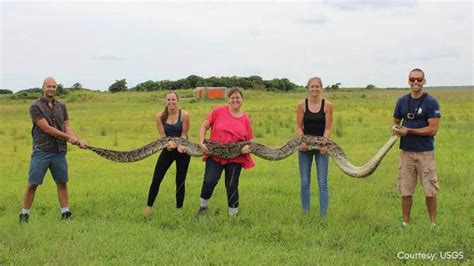
A trio of snake hunters in Florida may have captured a record-breaking Burmese python, measuring nearly 20 feet long and weighing 125 pounds, potentially unseating the current record holder.
Three men, Jake Waleri, Stephen Gauta, and Brandon Strain, captured the massive snake in the Florida Everglades, sparking excitement among wildlife officials and python enthusiasts. The python was caught near Naples, Florida, in the Picayune Strand State Forest. Waleri, who was part of the group, described the moment they encountered the snake, stating, “We knew it was a big snake, but we didn’t think it was going to be that big.” The hunters safely captured and dispatched the python before reporting the find to the Florida Fish and Wildlife Conservation Commission (FWC). If officially confirmed, this snake would surpass the existing record for the longest Burmese python captured in Florida, which measured just over 19 feet.
The capture highlights the ongoing challenges Florida faces with invasive Burmese pythons and underscores the importance of python removal programs. The FWC encourages the public to report sightings and participate in permitted removal efforts to help manage the population of these non-native snakes.
A Potentially Record-Breaking Catch
The massive python, if verified, would represent a significant milestone in the state’s efforts to control the invasive species. While the exact measurements are pending official confirmation, initial assessments suggest that it exceeds the length of the current record-holder. The previous record was a 19-foot Burmese python captured in 2020.
The three men involved in the capture are experienced python hunters. According to Waleri, the team was actively hunting in the Picayune Strand State Forest when they encountered the massive snake. The area is known to be a hotspot for python activity, largely due to the dense vegetation and abundant prey.
“It was surreal,” Gauta stated, describing the adrenaline-pumping moment when they realized the size of the python. “We knew we had to act quickly and safely.”
The FWC responded to the capture with cautious optimism. “This is a potentially significant find,” said a spokesperson for the FWC. “We are working to verify the measurements and gather more information about the snake.”
The capture has been hailed as a success story for the state’s python removal programs. These programs incentivize hunters to remove pythons from the Everglades and other areas, offering cash rewards based on the size and number of snakes captured.
The Invasive Burmese Python: A Threat to Florida’s Ecosystem
Burmese pythons are native to Southeast Asia and are believed to have been introduced to Florida through the pet trade. They were first discovered in the Everglades in the late 1990s, and their population has since exploded, causing significant ecological damage.
These pythons are apex predators, meaning they have no natural predators in Florida. They prey on a wide variety of native wildlife, including birds, mammals, and reptiles. Their voracious appetites have led to dramatic declines in populations of several native species, including raccoons, opossums, and bobcats, in areas where pythons are abundant.
The impact of Burmese pythons on Florida’s ecosystem is profound. In addition to directly preying on native wildlife, they also compete with native predators for food and resources. Their presence has disrupted the natural balance of the Everglades and other ecosystems, threatening the biodiversity of the region.
Efforts to Control the Python Population
The state of Florida has implemented a range of programs to control the Burmese python population. These programs include:
- Python Removal Programs: These programs incentivize hunters to remove pythons from the Everglades and other areas. Hunters are paid based on the size and number of snakes they capture. The FWC also organizes organized python hunts and challenges to encourage participation in these efforts.
- Research and Monitoring: Scientists are conducting research to better understand the ecology of Burmese pythons and to develop more effective methods for controlling their population. This research includes studies on python behavior, diet, and habitat use.
- Public Education: The FWC is working to educate the public about the threats posed by Burmese pythons and to encourage people to report sightings of these snakes. The public is also encouraged to avoid releasing exotic pets into the wild, as this is a major pathway for the introduction of invasive species.
- Regulations: The state has implemented regulations to restrict the importation and sale of Burmese pythons. These regulations are designed to prevent further introductions of these snakes into the wild.
One of the most successful python removal initiatives is the Florida Python Challenge, an annual event that encourages both professional and novice hunters to remove pythons from designated areas. The challenge provides training and resources to participants and offers prizes for the largest and most pythons captured.
These programs have resulted in the removal of thousands of pythons from the Everglades. However, controlling the python population remains a significant challenge. The snakes are highly adaptable and can survive in a wide range of habitats. They are also difficult to detect, as they are often well-camouflaged and spend much of their time underground or in the water.
The ongoing efforts to control the Burmese python population in Florida are essential for protecting the state’s native wildlife and ecosystems. While the challenge is significant, the state is committed to continuing its efforts to manage this invasive species.
The Significance of This Capture
The potential record-breaking capture of this Burmese python underscores the success and importance of Florida’s python removal programs. It demonstrates that these programs are effective at removing large, reproductively active pythons from the environment.
The capture also highlights the need for continued vigilance and investment in python control efforts. While the state has made significant progress in managing the python population, there is still much work to be done.
The FWC continues to refine its strategies for controlling the python population, incorporating new research and technologies. For example, the agency is exploring the use of scent detection dogs and thermal imaging to locate pythons.
The capture of this massive python serves as a reminder of the ongoing threat posed by invasive species to Florida’s ecosystems. It also serves as a testament to the dedication and hard work of the individuals and organizations working to protect the state’s native wildlife.
Expert Opinions and Insights
Wildlife experts emphasize the urgency of addressing the invasive python issue. Dr. Kristen Hart, a research ecologist with the U.S. Geological Survey, noted, “The removal of large female pythons is critical because these snakes can lay dozens of eggs each year. Removing even a few large females can have a significant impact on the population.”
Another expert, Dr. Joe Wasilewski, a conservation biologist specializing in reptiles, added, “These pythons are incredibly adaptable, and they’re able to exploit a wide range of habitats and food sources. This makes them very difficult to control.” He also emphasized the importance of a multi-faceted approach, including removal programs, research, and public education. “We need to continue to invest in all of these areas if we want to effectively manage the python population.”
The capture of this massive python has also sparked renewed interest in the issue of invasive species among the general public. Many people are now more aware of the threat posed by Burmese pythons and are more likely to report sightings of these snakes.
The FWC encourages the public to report any sightings of Burmese pythons, even if they are not able to capture the snake themselves. The agency uses these reports to track the distribution of pythons and to prioritize removal efforts.
Future Directions and Challenges
Looking ahead, the state of Florida faces several challenges in its efforts to control the Burmese python population. One of the biggest challenges is the vastness of the Everglades and other areas where pythons are found. These areas are difficult to access and survey, making it challenging to locate and remove pythons.
Another challenge is the cryptic nature of pythons. These snakes are often well-camouflaged and spend much of their time hidden, making them difficult to detect.
The FWC is working to address these challenges by developing new technologies and strategies for detecting and removing pythons. For example, the agency is exploring the use of drones and artificial intelligence to identify potential python habitats.
The state is also working to expand its partnerships with other organizations and agencies to enhance its python control efforts. These partnerships include collaborations with universities, federal agencies, and non-profit organizations.
The long-term goal is to reduce the python population to a level where it no longer poses a significant threat to Florida’s native wildlife and ecosystems. While this goal is ambitious, the state is committed to continuing its efforts to manage this invasive species.
The ongoing efforts to control the Burmese python population in Florida are a model for other states and countries facing similar challenges with invasive species. The state’s experience provides valuable lessons about the importance of early detection, rapid response, and long-term commitment to managing invasive species.
The recent capture of the potentially record-breaking python is a significant event, but it is just one chapter in the ongoing story of Florida’s fight against invasive species. The state’s commitment to this fight will be crucial for protecting its unique and valuable ecosystems for future generations.
The successful capture also highlights the crucial role of the hunters involved. Individuals like Waleri, Gauta, and Strain dedicate significant time and effort to python removal, often in challenging conditions. Their expertise and dedication are invaluable to the state’s efforts to control the invasive species.
The Economic Impact of Invasive Species
Beyond the ecological damage, invasive species also have significant economic impacts. In Florida, the cost of managing invasive species runs into the hundreds of millions of dollars each year. This includes the cost of removal programs, research, and damage control.
The economic impacts of invasive species are not limited to the direct costs of management. Invasive species can also damage agriculture, forestry, and tourism, leading to further economic losses.
For example, the citrus industry in Florida has been severely impacted by the Asian citrus psyllid, an invasive insect that carries a disease called citrus greening. This disease has decimated citrus groves and cost the industry billions of dollars.
Invasive species also pose a threat to human health. Some invasive species, such as mosquitoes and ticks, can transmit diseases to humans. Others, such as toxic algae, can contaminate water supplies and cause illness.
The economic impacts of invasive species are a major concern for the state of Florida. The state is committed to investing in programs and policies to prevent and manage invasive species in order to protect its economy and its environment.
The Role of Citizen Science
Citizen science plays an important role in the fight against invasive species. Citizen scientists are volunteers who collect data and conduct research to help scientists understand and manage invasive species.
In Florida, citizen scientists participate in a variety of projects, including monitoring for invasive plants, reporting sightings of invasive animals, and helping to remove invasive species from natural areas.
Citizen science projects provide valuable data to scientists and help to raise awareness about the issue of invasive species. They also provide opportunities for people to get involved in conservation efforts and to make a difference in their communities.
The FWC encourages people to get involved in citizen science projects to help protect Florida’s natural resources. There are many opportunities available, ranging from simple tasks like reporting sightings of invasive species to more involved activities like participating in organized removal efforts.
The Future of Python Control
The future of python control in Florida will depend on a number of factors, including the development of new technologies, the availability of funding, and the continued commitment of the state and its partners.
One promising area of research is the development of new attractants that can be used to lure pythons into traps. Scientists are working to identify chemicals that are attractive to pythons and to develop effective trapping methods.
Another area of research is the use of biological control agents to control python populations. Biological control involves introducing natural enemies of pythons, such as viruses or parasites, to help reduce their numbers.
The state is also working to improve its ability to detect pythons using remote sensing technologies. This includes the use of drones and satellites to identify potential python habitats and to track the movement of pythons.
The long-term goal is to develop a comprehensive strategy for controlling the python population that integrates a variety of methods, including removal programs, research, and technology.
The challenge of controlling the Burmese python population in Florida is significant, but the state is committed to continuing its efforts to manage this invasive species and to protect its native wildlife and ecosystems. The recent capture serves as a beacon of hope, showcasing the effectiveness of current strategies and motivating ongoing efforts to safeguard Florida’s environment.
FAQ: Burmese Pythons in Florida
Q1: How did Burmese pythons get to Florida?
A1: Burmese pythons are native to Southeast Asia and were likely introduced to Florida through the pet trade. Some may have escaped or been intentionally released into the wild.
Q2: Why are Burmese pythons a problem in Florida?
A2: They are apex predators with no natural enemies in Florida, preying on native wildlife such as birds, mammals, and reptiles, leading to declines in their populations.
Q3: What is Florida doing to control the python population?
A3: Florida employs various methods including incentivized removal programs, research and monitoring, public education campaigns, and regulations restricting the import and sale of Burmese pythons.
Q4: What can I do if I see a Burmese python in Florida?
A4: Report the sighting to the Florida Fish and Wildlife Conservation Commission (FWC) immediately. Do not approach or attempt to handle the snake yourself.
Q5: How big can Burmese pythons get in Florida?
A5: Burmese pythons in Florida can grow to be very large. The current record is just over 19 feet. The recently captured snake is suspected to be nearly 20 feet and weighing 125 pounds and if verified, it will set a new record.









